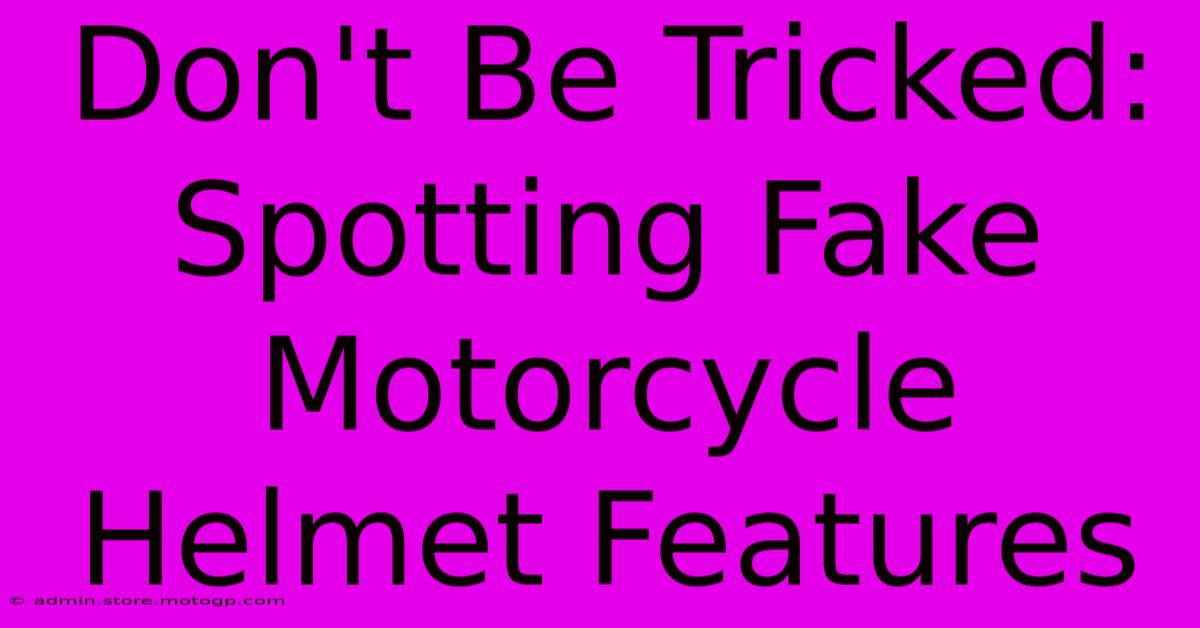Don't Be Tricked: Spotting Fake Motorcycle Helmet Features

Table of Contents
Don't Be Tricked: Spotting Fake Motorcycle Helmet Features
Buying a motorcycle helmet is a serious investment – it's your head's best friend on the road. But the market is flooded with counterfeit helmets, often sporting convincing imitations of genuine safety features. Don't fall victim to these fakes; your safety depends on having a helmet that truly meets safety standards. This guide will help you spot the tell-tale signs of a fake motorcycle helmet, so you can ride with confidence.
The Danger of Fake Motorcycle Helmets
Counterfeit helmets are often made with substandard materials and lack crucial safety certifications like DOT (Department of Transportation) or ECE (Economic Commission for Europe) approvals. These certifications ensure the helmet meets rigorous impact and penetration resistance standards. A fake helmet might look the part, but it offers significantly less protection in a crash, potentially leading to severe head injuries or even death. Don't risk it.
Key Indicators of a Fake Motorcycle Helmet
Identifying a fake requires careful inspection. Here are some red flags to watch out for:
-
Unclear or Missing Certifications: Legitimate helmets will clearly display their safety certifications (DOT, ECE, Snell, etc.) Look for a clearly visible and properly affixed sticker or label. If the certification is blurry, poorly printed, or missing altogether, be extremely wary.
-
Poorly Constructed Shell: Inspect the helmet's shell meticulously. Fake helmets often exhibit poor finishing, with uneven paint jobs, misaligned seams, and loose or wobbly parts. Genuine helmets have a smooth, consistent finish.
-
Suspiciously Low Price: If a helmet's price seems too good to be true, it probably is. High-quality helmets utilize advanced materials and manufacturing processes, making them inherently more expensive. A significantly discounted price is a major red flag.
-
Generic or Unfamiliar Branding: Be cautious of helmets with unfamiliar or generic brand names. While lesser-known brands can be legitimate, thorough research is crucial. Look for established brands with a reputation for safety and quality.
-
Substandard Straps and Buckles: Check the chin strap and buckle mechanism. Fake helmets often have weak, poorly stitched straps and flimsy, unreliable buckles. A genuine helmet will have strong, durable straps and a securely fastening buckle.
-
Missing or Inadequate Interior Padding: Remove the cheek pads and examine the helmet's interior. Fake helmets may have minimal padding or use inferior materials that offer little comfort or protection. Genuine helmets usually have well-padded interiors for a comfortable and secure fit.
-
Unrealistic Graphics or Logos: Look for blurry, uneven, or oddly placed graphics and logos. Counterfeiters often struggle to perfectly replicate official branding.
-
Unprofessional Packaging and Documentation: The packaging and any accompanying documentation should appear professional and contain detailed information about the helmet's specifications and safety certifications. Poor quality printing or the absence of documentation should raise your suspicion.
-
Unusual Sales Channels: Be wary of purchasing helmets from unofficial sellers or sources like unverified online marketplaces or social media platforms, especially if the price is significantly lower than retail. Stick to reputable retailers and authorized dealers.
How to Buy a Genuine Motorcycle Helmet
To ensure you're getting a real, safe helmet:
- Buy from Reputable Retailers: Purchase your helmet from a trusted motorcycle gear retailer, either online or in person.
- Verify Certifications: Always confirm the presence and legitimacy of the safety certifications.
- Read Reviews: Check online reviews from verified buyers to see if others have had positive experiences with the retailer and specific helmet model.
- Check the Manufacturer's Website: Visit the helmet manufacturer's website to verify the authenticity of the helmet you're considering buying.
Your safety shouldn't be compromised. Taking the time to carefully inspect a helmet and verify its authenticity will protect you from the dangers of counterfeit products. Remember, a helmet is an investment in your life; don't let a low price tempt you into risking your safety.

Thank you for visiting our website wich cover about Don't Be Tricked: Spotting Fake Motorcycle Helmet Features. We hope the information provided has been useful to you. Feel free to contact us if you have any questions or need further assistance. See you next time and dont miss to bookmark.
Featured Posts
-
American Moto Gp Riders Mental Toughness
Feb 17, 2025
-
Moto Gp Crash The Will To Win
Feb 17, 2025
-
The Art Of Riding Explore Our Replica Helmet Collection
Feb 17, 2025
-
Moto Gp Racing Time A Beginners Guide
Feb 17, 2025
-
The Technology Of American Moto Gp
Feb 17, 2025
